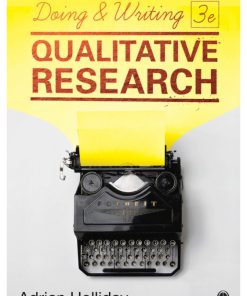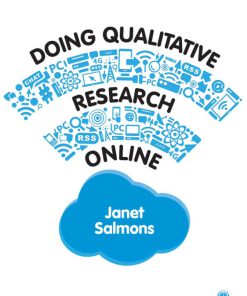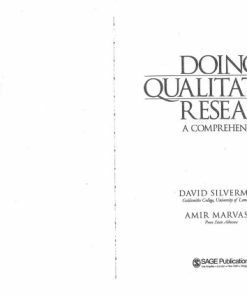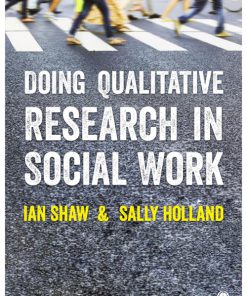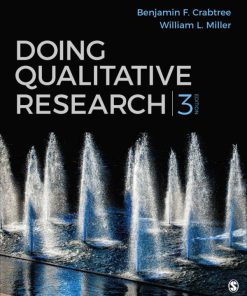Doing Interview based Qualitative Research A Learner’s Guide 1st edition by Eva Magnusson,Jeanne Marecek 1316418278 9781316418277
$50.00 Original price was: $50.00.$25.00Current price is: $25.00.
Authors:Eva Magnusson; Jeanne Marecek , Series:Psychology [39] , Tags:Psychology; General; Research & Methodology; Reference; Research; Social Science , Author sort:Magnusson, Eva & Marecek, Jeanne , Ids:9781107062337 , Languages:Languages:eng , Published:Published:Oct 2015 , Publisher:CAMBRIDGE UNIVERSITY PRESS , Comments:Comments:For many students, the experience of learning about and using qualitative methods can be bewildering. This book is an accessible step-by-step guide to conducting interview-based qualitative research projects. The authors discuss the ‘hows’ and ‘whys’ of qualitative research, showing readers the practices as well as the principles behind them. The book first describes how to formulate research questions suited to qualitative inquiry. It then discusses in detail how to select and invite research participants into a study and how to design and carry out good interviews. It next presents several ways to analyze interviews and provides readers with many worked examples of analyses. It also discusses how to synthesize findings and how to present them. Doing Interview-based Qualitative Research equips readers in disciplines such as psychology, sociology, education, counseling, nursing, and public health with the knowledge and skills necessary to embark on their own projects.
Doing Interview based Qualitative Research A Learner’s Guide 1st edition by Eva Magnusson,Jeanne Marecek – Ebook PDF Instant Download/Delivery.9781316418277, 1316418278
Full download Doing Interview based Qualitative Research A Learner’s Guide 1st edition after payment

Product details:
ISBN 10:1316418278
ISBN 13:9781316418277
Author:Eva Magnusson,Jeanne Marecek
For many students, the experience of learning about and using qualitative methods can be bewildering. This book is an accessible step-by-step guide to conducting interview-based qualitative research projects. The authors discuss the ‘hows’ and ‘whys’ of qualitative research, showing readers the practices as well as the principles behind them. The book first describes how to formulate research questions suited to qualitative inquiry. It then discusses in detail how to select and invite research participants into a study and how to design and carry out good interviews. It next presents several ways to analyze interviews and provides readers with many worked examples of analyses. It also discusses how to synthesize findings and how to present them. Doing Interview-based Qualitative Research equips readers in disciplines such as psychology, sociology, education, counseling, nursing, and public health with the knowledge and skills necessary to embark on their own projects.
Doing Interview based Qualitative Research A Learner’s Guide 1st Table of contents:
1 Introduction
Introducing interpretative research
The theoretical framework for the book: some building blocks
Culture
Meaning
Talk and language
Interviews
Our aims for the book: bringing practice and theory together
The road map for the book
2 Some examples of interpretative research
Self-esteem as folk theory: comparing mothers in Taiwan and the USA
1 The researcher’s knowledge interest
2 The researchable questions that the researcher developed for the project
3 What the researcher did to gather material
4 Examples of analyses and findings in the project
Repeated hospitalizations for severe mental disorders in an American community
1 The researcher’s knowledge interest
2 The researchable questions that the researcher developed for the project
3 What the researcher did to gather material
4 Examples of analyses and findings in the project
The spiral of suicide-like behavior among adolescent girls in Sri Lanka
1 The researcher’s knowledge interest
2 The researchable questions that the researcher developed for the project
3 What the researcher did to gather material
4 Examples of analyses and findings in the project
Heterosexual couples in the Nordic countries forming their identities within and against gender equality ideologies
1 The researcher’s knowledge interest
2 The researchable questions that the researcher developed for the project
3 What the researcher did to gather material
4 Examples of analyses and findings in the project
Canadian women’s medicalized accounts of depression
1 The researcher’s knowledge interests
2 The researchable questions that the researcher developed for the project
3 What the researcher did to gather material
4 Examples of analyses and findings in the project
In conclusion: what unites interpretative research?
3 Planning and beginning an interpretative research project
Keeping a research journal
Reading as an interpretative researcher
Learning from knowledgeable people
Assessing feasibility
Researchable questions in interpretative research
Expect to modify your researchable questions
4 Making decisions about participants
Specifying the group(s) of people to study
Specifying groups to study is always purposive
Setting the number of participants for your study
Reaching out to potential participants
Putting the recruitment techniques into use
Composing the message to potential participants
Contacting and enlisting participants
Setting up the interview situation
Compensating participants
Ethical regulations of research
5 Designing the interview guide
Semi-structured interviews and open-ended questions
Rich talk in interviews
The interviewer–participant relationship
Researchable questions are not interview questions
Developing the interview content
Composing interview questions about your topics
Follow-up questions
Putting the items in sequence
The first segment of the interview guide
The main body of the interview guide
Ending the interview guide
Pretests and pilot tests
6 Doing the interview
An overview of the research interview
The preliminaries
Opening the interview
The main body of the interview
Closing the interview
Practical techniques: typical situations
How to establish and maintain a conversational tone and atmosphere
How to provide structure for the interview conversation
How to guide the content of the conversation
How to be an active listener
Practical techniques: complicated situations
When a participant seems reluctant
When a participant is taciturn and takes few initiatives to speak
When a topic or question does not “work”
Uncomfortable or painful feelings in interviews
The interviewer in the interview
The relationship between interviewer and participant in the interview
Pilot-testing the interview guide and practicing the interview
Why should you pilot-test the interview guide?
How to pretest, pilot-test, and revise the interview guide
How to use pretesting to develop your interviewing skills
7 Preparing for analysis
Transcribing your interviews
When to transcribe
What to transcribe
Completing the transcription
Ethical issues in transcribing
Original language in transcripts and publishing language
Our use of transcripts in this book
Ensuring that your project meets a high standard
Turning to analysis
Overview of the analysis chapters
Chapter 8: Finding meanings in people’s talk
Chapter 9: Analyzing stories in interviews
Chapter 10: Analyzing talk-as-action
Chapter 11: Analyzing for implicit cultural meanings
Appendix: Notation system for transcribing interview talk
8 Finding meanings in people’s talk
Formulating sub-questions for analysis
Karin’s project
Matt’s project
Selecting excerpts and assembling a file for each sub-question
How much material should be included in an excerpt?
Examples of excerpts
Deciding if an interview segment is relevant to a sub-question
Annotating the excerpts
Examples of notes about excerpts
Finding repeating ideas and composing integrative summaries and labels
Example 1
Example 2
Example 3
Things to keep in mind while you select excerpts and make summaries
Exploring differences between people
Drawing your analyses together
9 Analyzing stories in interviews
Analytical framework
Dimensions of stories
“Trouble”: the instigation to make a story
The teller’s “Theory of the Event”
The teller’s evaluative perspective
Canonical narratives
How to interpret stories: reading content and form together
Analytical procedures
Creating a file of excerpts
Becoming familiar with the contents of the file
Selecting dimensions of stories for analysis
Making notes about participants’ stories
Example 1: Katie
Notes
Example 2: Jennifer
Notes
Example 3: Lucy
Notes
Example 4: Maribeth
Notes
Finding similar meanings and composing integrative summaries of them
Stories in the file Theory of the Event
Integrative summary
Verifying the analyses
What to do if you are stuck
Drawing the analyses together
Example 1
Example 2
Exploring differences between groups of people
Comparing daughters and mothers: what is the Trouble or problematic event?
Comparing mothers and daughters: taking a canonical narrative into use
Synthesizing the analyses
10 Analyzing talk-as-action
What is talk-as-action?
Analytical framework
Rhetoric
Talking, thinking, and rhetoric
Language, categorization, and argumentation
Rhetorical contexts
The rhetorical context of interview interactions
Analytical procedures
Talk-as-action and the researchable questions in a study
Identifying pieces of talk to study
The phases of the analysis
Analyzing conversational features
“Witcraft” – statements plus justifications
Expressions of disagreement
Contrasting and extreme cases
Metacommunication in interviews
Variability in accounts: when participants contradict themselves
Emphasizing consensus and corroboration by others
Reported speech in interviews
Descriptions and facts
Descriptions and vivid descriptions
Systematic vagueness in descriptions
Empiricist accounting in descriptions
Category entitlement
The purposes of analyzing talk-as-action
11 Analyzing for implicit cultural meanings
Analytical framework: implicit cultural meanings
Terminology in this chapter
Analytical procedures
(A) Group-focused analysis of implicit cultural meanings
The first step: selecting the material to analyze
The second step: from researchable questions to group commonalities
The third step: from group commonalities to implicit cultural meanings
Toward drawing conclusions: bringing in the larger picture of the study to verify ideas
Toward synthesizing and drawing conclusions
Outline of the steps in the analysis
Analytical procedures
(B) Studying an individual’s meaning-making in a cultural context
The analysis example
Birgitta, her husband, and the professional women
How to select excerpts for analysis
Reading and reflecting: the preliminary step
Subjects and verbs: beginning to identify the action in Birgitta’s account
Textual subjects in Birgitta’s story
Identifying textual subjects that seem to disagree
Textual subjects that seem to agree: on the way to identifying cultural meanings
Identifying textual subjects that agree
From agreeing textual subjects to implicit cultural meanings
Discussing the implicit cultural meanings
Toward synthesizing the results
Outline of the steps in analysis of individual excerpts for implicit cultural meanings
12 Reporting your project
What the research report contains
The Methods section
(1) About the participants
(2) About the interview
(3) About the procedures for analyzing
The Results and Discussion section
The Introduction
The Conclusion
Language, style, and ethics in scientific writing
Using material from your interviews in your report
Avoid formal language
Avoid imprecise or misleading terms borrowed from other fields
Avoid discriminatory language
Safeguard the anonymity of your participants and their communities
Languages and writing styles
When you move between languages
Plagiarism
Authorship
Where to publish
Epilogue
Using semi-structured interviews
Selecting research participants purposively
Formulating open researchable questions
Refining and augmenting the researchable questions as the research unfolds
People also search for Doing Interview based Qualitative Research A Learner’s Guide 1st:
doing interview-based qualitative research
doing interview based qualitative research pdf
doing interview based qualitative research a learner’s guide
doing interviews
doing qualitative research in education settings
You may also like…
eBook EPUB
Doing and Writing Qualitative Research 3rd Edition by Adrian Holliday ISBN 9781473968301 1473968305
eBook PDF
Doing Qualitative Research in Education Settings 1st edition by Amos Hatch 9780791487945 0791487946



